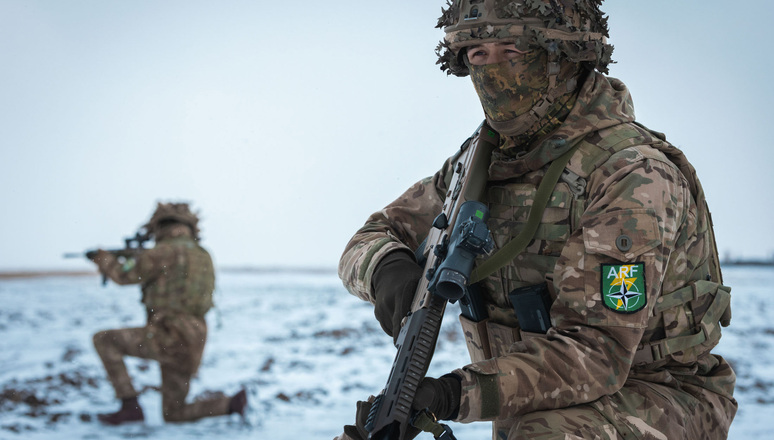Allied Reaction Force (ARF)
- English
- French
The Allied Reaction Force (ARF) is a high-readiness, multinational and multi-domain force that can be deployed at very short notice to carry out a wide range of missions. Many current challenges, such as hybrid warfare, terrorism and cyber attacks, require a coordinated response across operational domains. For this reason, the ARF includes land, maritime, air, Special Operations Forces, cyber, space, logistics and strategic communications elements, provided by NATO member countries through a rotational system. Flexible, scalable and multinational by design, the ARF is a clear demonstration of Allied capability, solidarity and resolve.

British Army soldiers during Steadfast Dart 25, the Allied Reaction Force’s first large-scale exercise, in Romania on 17 February 2025.
- The Allied Reaction Force is capable of carrying out the Alliance’s full spectrum of missions in support of NATO’s three core tasks (deterrence and defence, crisis prevention and management, and cooperative security).
- It is a robust, multi-domain force that can be rapidly reinforced with additional units as needed.
- It operates under the overall command of the Supreme Allied Commander Europe (SACEUR). NATO Rapid Deployable Corps Italy (NRDC-ITA) currently serves as the ARF Headquarters.
- The ARF is a component of the NATO Force Model, the framework through which the Alliance organises, manages, activates and commands Allied national forces in support of NATO’s three core tasks.
Purpose
The ARF provides NATO with a strategic, high-readiness, multi-domain and multinational capability that can be deployed immediately on the orders of the Supreme Allied Commander Europe (SACEUR) to strengthen deterrence in peacetime and crisis, and support the Alliance’s defence in conflict.
The ARF is flexible, scalable and capable of carrying out the Alliance’s full spectrum of missions in and outside SACEUR’s Area of Responsibility in support of NATO’s three core tasks:
- It can serve as a rapidly deployable strategic reserve and can be used to deter aggression or escalation as part of NATO’s deterrence and defence posture.
- It can be deployed in response to crises or other emerging situations as part of NATO’s crisis prevention and management efforts.
- And it can be employed to test capabilities, train forces and build interoperability with partners as part of NATO’s commitment to cooperative security.
Ultimately, the ARF ensures that highly prepared forces are readily available to SACEUR, providing rapid response options for any situation.
Key components
The ARF includes land, maritime, air, Special Operations Forces, cyber, space, logistics and strategic communications elements. It is a robust, multi-domain force that can be rapidly reinforced with additional units as needed.
The ARF is sourced by a mix of force generation forces (which are provided by Allies on a voluntary basis) and augmentation from the NATO Force Model, as required. As an element of the NATO Force Model, the ARF is part of the Alliance’s three-tiered readiness system, which ensures that forces are available to respond at very short notice for collective defence and other crises.
The components allocated to the ARF are drawn from across NATO member countries through a rotational system, in which Allies take the lead of the ARF’s component commands, typically for one year:
- The Land Component Command is led by the Italian “Vittorio Veneto” Division in 2025, following the 1st UK Division in 2024.
- The Maritime Component Command is led by the Spanish Maritime Forces (SPMARFOR) in 2025, following the Italian Maritime Forces (ITMARFOR) in 2024.
- The Special Operations Component Command has been led by the Spanish Joint Special Operations Command in 2024 and 2025.
- The Joint Logistic Support Group is led by the French Armed Forces in 2025, following the NATO Rapid Deployable Corps Italy (NRDC-ITA) in 2024.
- When required, Allied Air Command (AIRCOM), the NATO Cyber Command and the NATO Space Centre will provide the ARF with the necessary assets and capabilities in their respective domains.
The ARF operates under the overall command of SACEUR. As of the ARF’s activation in July 2024, NATO Rapid Deployable Corps Italy has been designated as the ARF Headquarters, serving as a transitional structure for three years, until permanent ARF structures are established.
Evolution
From 2002 until 2024, the NATO Response Force (NRF) served as the Alliance’s primary tool for force generation and rapid response in support of NATO’s three core tasks. The establishment of the Allied Reaction Force and the NATO Force Model in 2024 was part of a broader restructuring of NATO’s high-readiness forces.
At the 2022 Madrid Summit, as part of strengthening and modernising the NATO Force Structure following Russia’s full-scale invasion of Ukraine earlier that year, Allies agreed to create the new NATO Force Model and began to implement it.
At the 2023 Vilnius Summit, NATO Leaders built on their Madrid decisions by approving a new generation of regional defence plans and agreeing to establish the Allied Reaction Force as part of the NATO Force Model.
In May 2024, participants from all 32 NATO Allies took part in exercise Steadfast Deterrence 2024, the ARF’s first major joint exercise. The exercise helped advance the transition from the NRF to the ARF, preparing the new Force to take on its key roles, including for collective defence.
The Allied Reaction Force was activated by NATO Allies in July 2024. At the same time as the ARF was activated, the NATO Force Model replaced the NATO Response Force as the framework to organise, manage, activate and command the Alliance’s forces.
In September 2024, approximately 200 personnel took part in the ARF Headquarters’ first deployment, conducting training in North Macedonia and Kosovo to ensure the ARF’s readiness to support the NATO-led Kosovo Force (KFOR).
In February 2025, the ARF participated in exercise Steadfast Dart 2025, the largest NATO exercise in 2025. The exercise marked the first large-scale deployment of the ARF, including all of its components, since its establishment in 2024. It tested the ARF’s deployable capabilities and procedures, as well as the interoperability among troop contributors and host countries.
